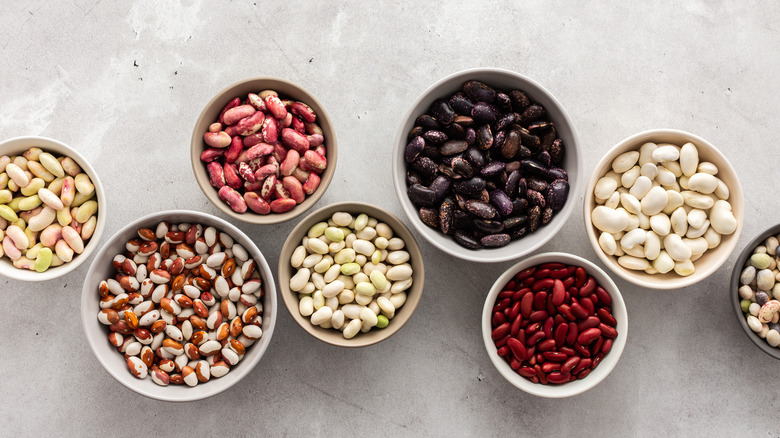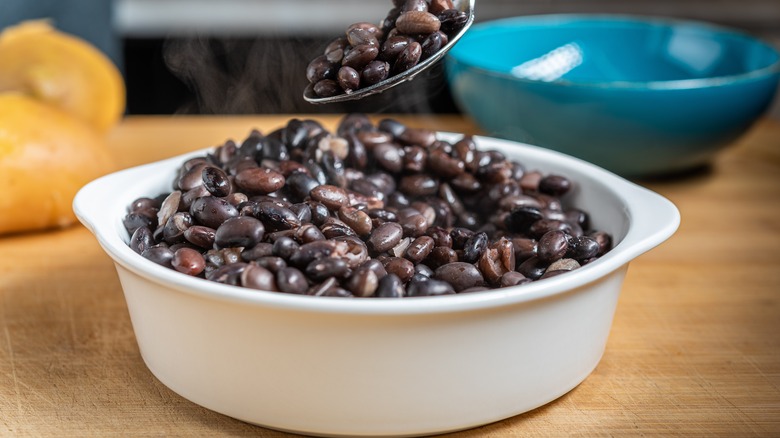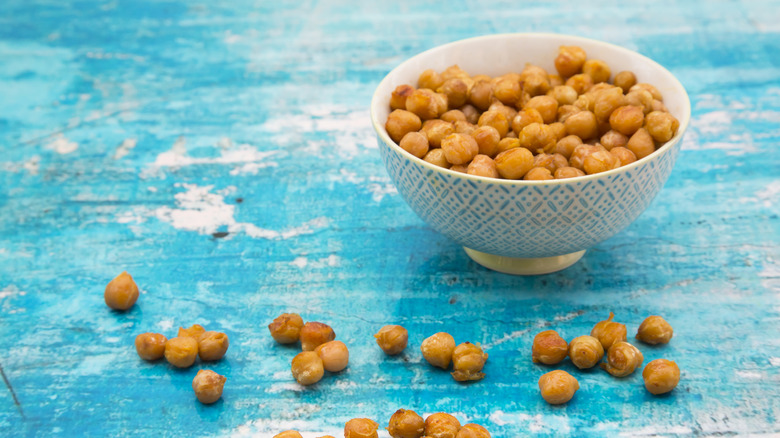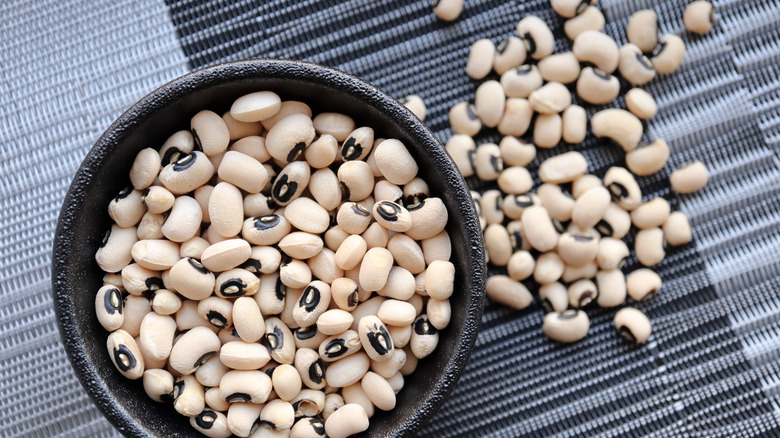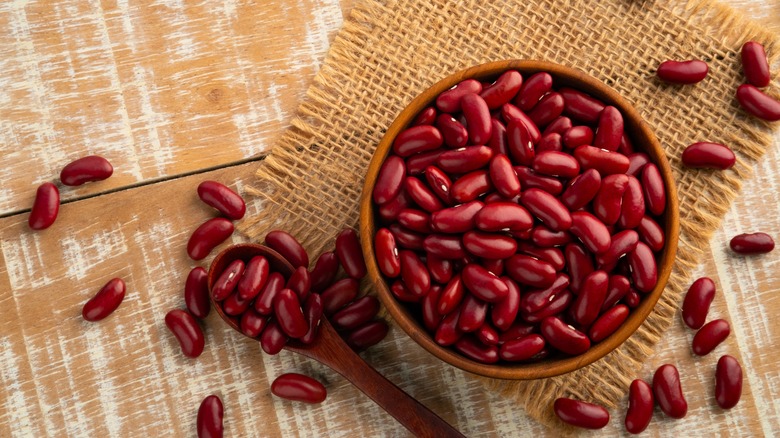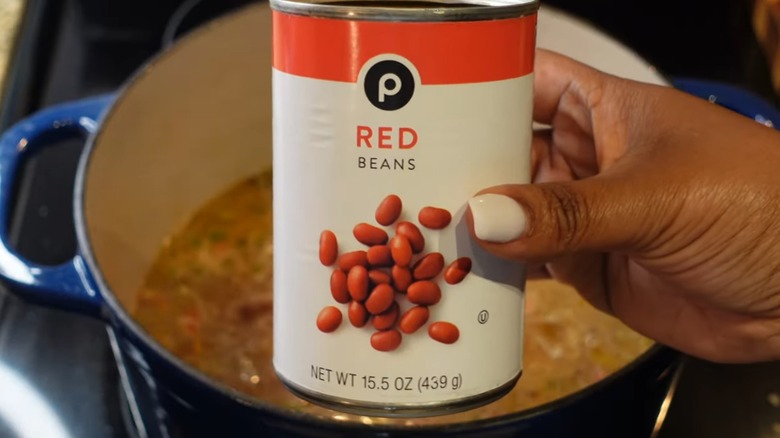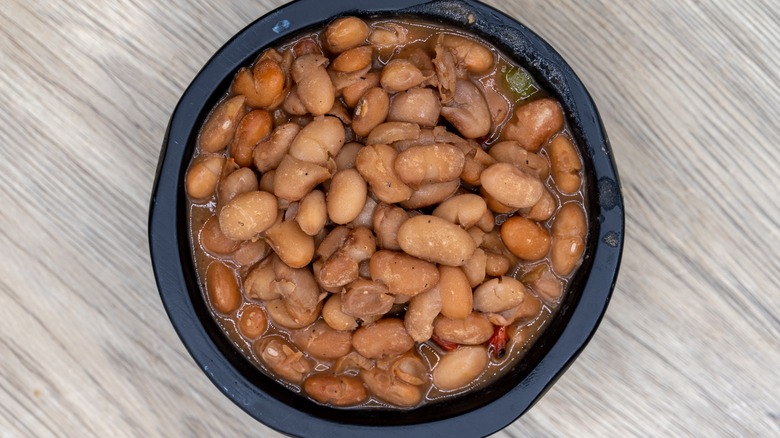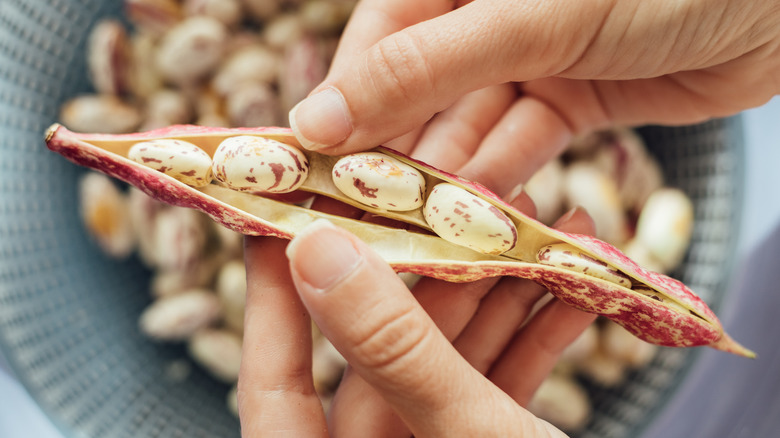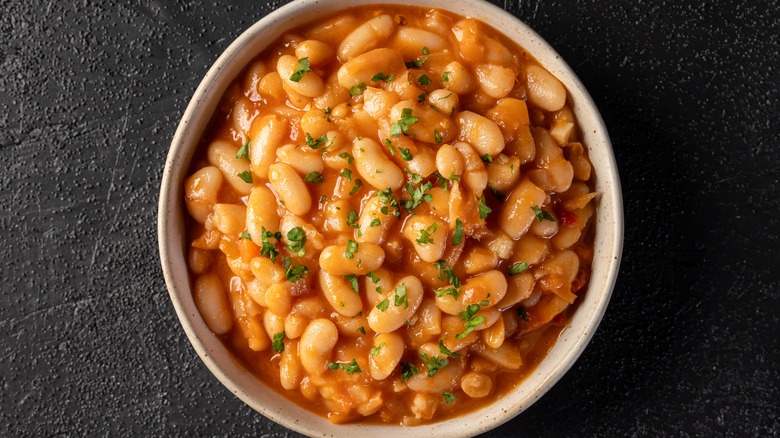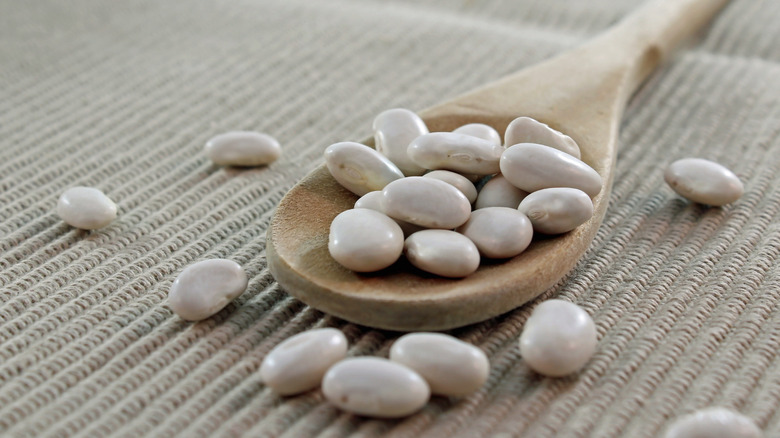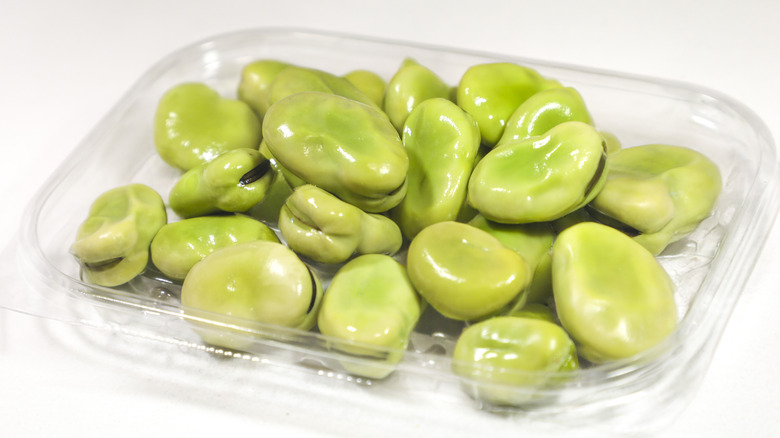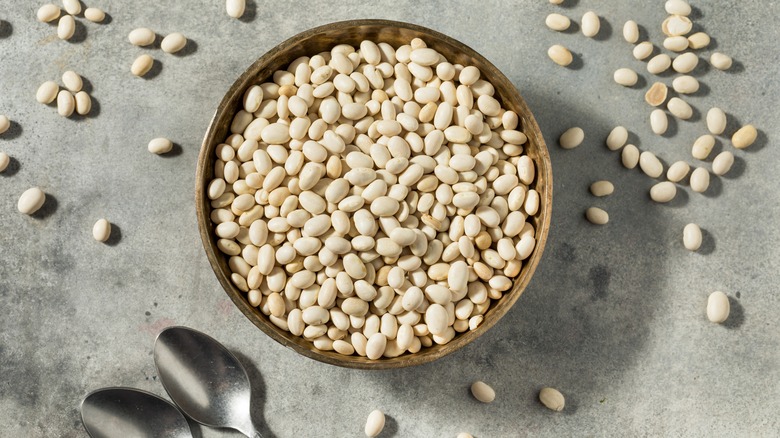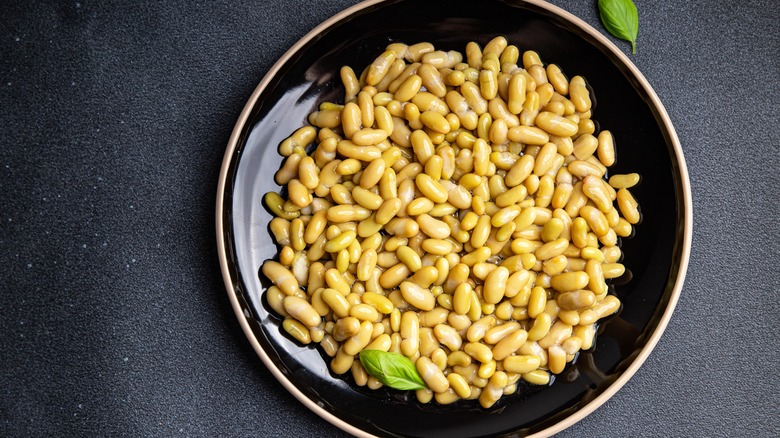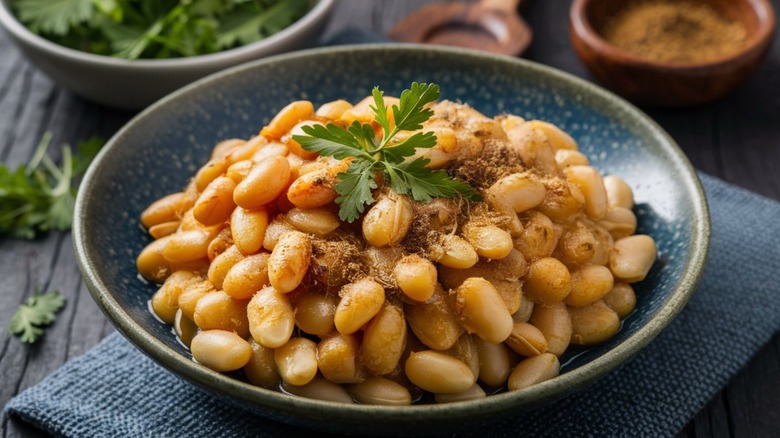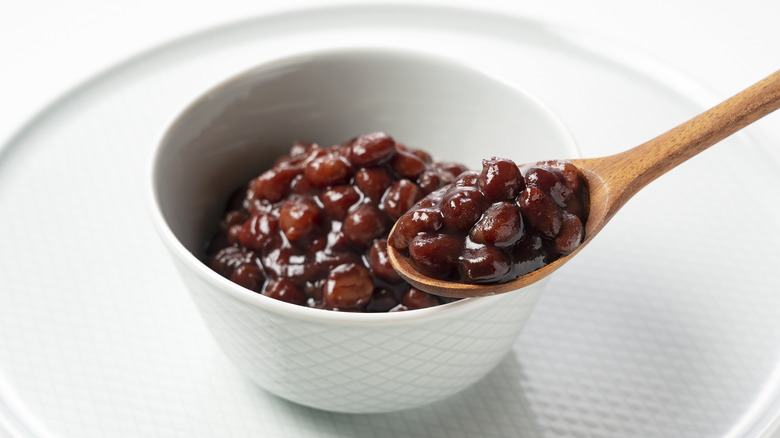14 Precooked Beans You Should Always Have On Hand
There're many good reasons why beans are a staple in diets around the world. They are incredibly versatile and can be used in a huge range of dishes, from hearty soups and stews to dips and salads. Part of a food group known as pulses, they are usually mild in flavor, which means that they are great at absorbing the ingredients and spices they are cooked with. Finally, beans are a nutritional powerhouse, rich in plant-based protein, dietary fiber, and essential vitamins and minerals like magnesium and iron.
Beans come in numerous varieties, each offering a unique flavor and texture. From earthy black beans to nutty chickpeas, this diversity can be an inspiration for endless creativity in the kitchen. While beans can be purchased fresh in season, they are also available in dried and canned forms to be enjoyed year-round. Although dried beans usually require presoaking and cooking, their canned counterparts are typically precooked and can be eaten straight out of the tin. With this in mind, here're some of the best canned beans to keep in your kitchen pantry.
1. Black beans
Also sometimes called turtle beans and caviar criollo, black beans are oval legumes similar in size to a pea. Black in color when raw, the beans become lighter during cooking. They have a white and creamy interior with a mild taste, which makes them a great vehicle for other flavors. Black beans were first cultivated in the Americas, with Mexico and Guatemala being the biggest exporters of the legume today.
Black beans play both center and supporting roles in many recipes and are a popular addition to Mexican and Creole dishes. At their simplest, the pulses can be turned into black bean soup with just a few additional ingredients such as diced tomatoes, vegetable broth, chili powder, garlic powder, and cumin. Those craving Latin American flavors can try making black bean enchiladas, sweet potato and black bean tacos, or bean and cheese gorditas filled with black beans, Cotija cheese, avocados, cumin, paprika, and lime juice.
2. Garbanzo beans
Perhaps the most well known culinary creation that incorporates garbanzo beans — or chickpeas, as they are sometimes called — is hummus. While the dip comes in many different variations, one of the more common ones is lemon hummus, which also includes tahini, olive oil, garlic, and a little lemon. Some recipes even throw a little lemon zest into the mix. Popular in the Mediterranean, Middle East and Africa, garbanzo beans are also the main ingredient in falafel and make a tasty addition to salads, curries, and stews.
Garbanzo beans are round and usually beige in color, although black, red, and green versions exist. They're earthy and somewhat nutty in flavor. Like many other beans, chickpeas make a healthy addition to a balanced diet. The legumes are rich in protein, fiber, vitamins, and minerals. Just some of the health benefits of incorporating garbanzo beans into your diet include better bone and heart health, lower blood pressure, and lower levels of so-called bad cholesterol.
3. Black-eyed peas
If you thought that black-eyed peas was just the name of a band, you're in for a shock. Also known as cowpeas, goat peas, and Southern peas, black-eyed peas are beans that can have a big impact in the kitchen. They're also visually striking, with a distinctive black spot that resembles an eye. Black-eyed peas are dense and creamy in texture and rich and earthy in taste, which means that they aren't easily overshadowed in hearty and flavorful dishes.
While black-eyed peas most likely came from North Africa to the Americas, they are very popular in dishes in the South, where they are often eaten on New Year's Eve for good luck. For a hearty and satisfying dish, try making spicy black-eyed pea soup. To make the meal, combine the beans with beef broth, spicy salsa, cumin, oregano, bay leaf, ham hocks, and cubed ham. Once cooked, throw a few spinach leaves into the mix and wait until they wilt.
4. Red kidney beans
Aptly named for their kidney shape and color, red kidney beans have a glossy reddish exterior. Cultivated as far back as 8,000 years ago in Peru, kidney beans are relatively sturdy, which means that they don't fall apart during cooking. One of the most popular dishes that incorporates red kidney beans is chili con carne. The beloved Tex-Mex dish is a spicy stew with ground beef and plenty of spices. Kidney beans can also add protein to salads, playing a starring role alongside ingredients such as celery and onions.
We recommend buying canned red kidney beans since the dried variety can be toxic if not thoroughly cooked. If you're determined to cook red kidney beans at home, the U.S. Food and Drug Administration's Bad Bug Book recommends soaking dried kidney beans in water for about five hours, dumping out that water, and then boiling the kidney beans in fresh water on high heat for 30 minutes. The agency advises never to cook kidney beans in the same water the beans were soaked in. Despite the risks, if handled properly, red kidney beans are very nutritious. More specifically, 100 grams of the pulses contain 6.4 grams of fiber and 8.7 grams of protein. They are also packed with vitamins and minerals such as folate, iron, potassium, and vitamin K1.
5. Red beans
People often ask whether red beans and kidney beans are the same. While the two pulse types are indeed similar, they are far from identical. Red beans are smaller than kidney beans and lack the kidney bean's distinctive curved shape. Perhaps one Quora member summarizes the differences between the two bean types best, saying, "Red beans are smaller with a smooth texture and a beany flavor whereas kidney beans are larger and absorb the flavors of the other ingredients." Additionally, while many say that the two bean types can be used interchangeably in a number of dishes, others are adamant that their taste and texture differences make this impossible.
One of the most popular recipes that utilizes the nutty and slightly sweet flavor of red beans is red beans and rice. Simple and filling, the dish features red beans as well as onions, green bell peppers, celery, vegetable broth, dry white wine, and a host of herbs and spices. The dish is often accompanied by sliced sausage for added richness; however, vegetarians can skip the meat or use a plant-based alternative.
6. Pinto beans
While pinto beans are similar in appearance to red beans once cooked, the pulses look nothing alike in their uncooked form. Fresh pinto beans are light beige with brownish speckles, giving them a spotty appearance. In contrast, red beans are characterized by a solid red color. The story is a little different when it comes to how the beans taste, with both types featuring a mild flavor and creamy texture.
Pinto beans play an important role in the cuisines of many Latin American countries and are the main ingredient in refried beans. If you don't want to buy them already made, you can easily make refried beans at home by mashing canned pinto beans with olive oil, onion, garlic, lemon juice, and spices, including onion powder, cumin, and chili powder. Like many other pulses, pinto beans make a great addition to soups and stews.
If you're looking for a healthy meal, pinto beans are a great choice. A cup of cooked pinto beans contains 15.4 grams of fiber and 15.4 grams of protein, as well as decent amounts of iron, potassium, and phosphorus. Pinto beans are also loaded with antioxidants, including polyphenols and flavonoids, which have been linked to better heart health and reduced inflammation.
7. Cranberry beans
Also known as borlotti beans and Roman beans, cranberry beans are visually striking. Beige-pink in color, the beans feature multiple red-brown speckles. In fact, cranberry beans are visually similar to pinto beans but are darker in color. Also, like pinto beans, cranberry beans lose their speckles once cooked. When it comes to flavor, cranberry beans boast a rich and nutty taste, while pinto beans are milder and earthier. Cranberry beans usually come dried, but they can also be purchased in a precooked, canned form.
Unlike pinto beans, which are often used in Latin American cooking, cranberry beans are popular in Portugal and Italy, where they are sautéed in oil and added to pastas or simmered in stews. One Reddit member recommends using cranberry beans in soups, adding, "They have a thicker skin (don't get mushy) and make a rich broth."
One of the most popular cranberry bean dishes is feijao a Portuguesa, which translates to Portuguese bean stew. The dish is a hearty mix of cranberry beans, bacon, sausage, paprika, tomatoes, and chili peppers. On the Italian front, cranberry beans are often used to make pasta e fagioli, or pasta and beans. Beyond cranberry beans and pasta, the dish also incorporates tomato puree, vegetable broth, veggies such as celery and carrots, and herbs and spices.
8. Cannellini beans
Sometimes called white kidney beans, cannellini are white beans with a slightly curved shape that resembles ... well, a kidney. Indeed, this is one of the ways that they can be distinguished from another white bean type — the great northern beans. Cannellini beans have an earthy and nutty flavor and retain their shape during cooking, which makes them ideal for soups, casseroles, and stews. Nevertheless, if you don't have them on hand, cannellini beans can be substituted with other beans, including great northern beans and navy beans.
While cannellini beans originated in South America, today they are particularly popular in Italy, where they are commonly added to dishes such as minestrone soup. One Quora member who lives in Italy describes the popularity of the cannellini beans there, saying, "They can be sautéed ... with garlic, sage and a little of tomato sauce, and they are called Fagioli all'Uccelletto, a full dish or a good side for sausages or roasts." The commenter also noted that cannellini can be found in pasta e fagioli, ribollita, and frantoiana with kale and beans, adding, "They are used in really hundreds of other ways, even [in] pasta sauces, [and] fish and seafood stews as they are quite versatile!"
9. Great northern beans
Great northern beans and cannellini beans are quite similar in appearance. They are both white and feature similar dimensions. This can make things tricky if a recipe calls for white beans, particularly since both feature some differences in flavors and textures. Vince Hayward, the president of Camellia Brand beans, explained the difference between the two bean types in an interview with EatingWell, saying that the cannellini bean is heartier than the northern bean. "The great northern is a bit more delicate and therefore lends itself towards consuming directly from a bowl, using as an ingredient in baking, or just simply when a lighter texture is desired," he said.
The mild, nutty flavor and soft texture of great northern beans makes them a great addition to stews, soups, and casseroles. The legumes absorb flavors, which means that they're not only going to add some hearty protein to your meal, but also enhance the overall taste and creaminess of the dish. For a simple and quick meal, try whipping up garlic and herb great northern beans by combining precooked beans with garlic, oregano, and a little lemon juice.
10. Fava beans
Fava beans, also known as broad beans, are large and oval shaped with a distinctive flatness similar to edamame. Fava beans are green when fresh and turn brown when cooked. They come encased in a thick pod, which needs to be removed prior to eating. While fresh or dried fava beans need to be blanched and boiled, they can also be purchased precooked in cans for convenience. Fava beans have a buttery and nutty flavor with a hint of bitterness, and, unlike most other beans, can be eaten raw.
Dating back to at least 6,000 B.C.E., fava beans are said to have been enjoyed by the ancient Greeks and Romans in the eastern Mediterranean. Today, fava beans have made a name for themselves globally. While they taste perfectly fine as a snack with a little salt, fava beans can also be sautéed, boiled, steamed, or fried. For a light meal, enjoy them in salads or gently cooked and served with your favorite veggies.
11. Navy beans
A type of white beans, navy beans are sometimes confused with two other white bean varieties: cannellini beans and great northern beans. The best way to distinguish among the three types of beans is by looking at their dimensions. Around the size of peas, navy beans are the smallest of the trio. Meanwhile, great northern beans are medium-sized, and cannellini beans are the largest. Navy beans are loaded with fiber, containing one of the highest levels of the nutrient among pulses, with 11 grams of fiber for each 100 grams of beans.
Navy beans have a buttery and earthy flavor and a soft and velvety texture, which makes them ideal for soups, purees, and stews. Navy beans are the star ingredient in Senate bean soup, a hearty dish with ham hocks, onion, stock, and celery that has been served in the U.S. Senate cafeteria since the early 20th century. While many Senate bean soup recipes call for dried beans, using precooked beans can speed up the cooking process.
12. Flageolet beans
Also sometimes called the caviar of beans due to their delicate flavor, flageolet beans originated in France in the late 19th century. Today, flageolet beans are mostly grown in various regions of France as well as in California. Around half-an-inch long and pale green or whitish in color, flageolet beans are slightly curved and tend to be a little pricier than most other canned beans — it turns out that they aren't called caviar of beans for nothing. Flageolet beans retain their shape and texture well during cooking, which makes them ideal for dishes that require beans to hold up without becoming mushy.
Ultra versatile, flageolet beans can be eaten on their own with a little butter or used in a huge range of recipes. In France, they are typically cooked with bacon, broth, rosemary, and bay leaf. In addition, the pulses make a tasty addition to stews alongside lamb, mutton, and poultry. Flageolet beans can also be used as a substitute in any recipe that calls for cannellini or great northern beans.
13. Lima beans
Named after their city of origin — Lima in Peru — Lima beans have been around for some 9,000 years. The beans are initially green in color and turn beige when mature — both bean colors are edible. Lima beans are also sometimes called butter beans due to their buttery, mild flavor and creamy texture. Slightly curved, fresh Lima beans come with an outer skin, which becomes tender enough to eat when the beans are precooked and canned. While Lima beans can be confused with edamame, the two pod types are very different. Fresh Lima beans have a slightly curved shape and are a little larger than edamame. They also tend to be flatter and milder in flavor.
Lima beans are multifaceted enough to use in a wide range of recipes. They can be mixed with ground beef, used in vegan jambalaya, or tossed with chopped tomatoes and a little garlic. Highlighting their versatility, British-Israeli chef Yotam Ottolenghi uses Lima beans to add a new twist to the traditional beans on toast recipe. Ottolenghi combines precooked Lima beans with pickled red onions and green chilis, cream, and cheddar cheese as well as a blend of herbs and spices and serves it atop toasted sourdough bread.
14. Adzuki beans
Adzuki beans look a little like unshelled peanuts. Once cooked, the reddish-brown pods swell up and soften, transforming into mildly sweet legumes that can be used in both savory and sweet dishes. Adzuki beans, which may also be called azuki or aduki beans, have been cultivated for around 2,000 years in East Asian countries, including Japan, China, Taiwan, and South Korea. The little legumes are a nutritional powerhouse, loaded with folate, fiber, manganese, potassium, phosphorus, and magnesium.
In Japan, adzuki beans are commonly boiled with sugar to make anko paste, which is then added to cakes, pastries, and other sweet treats. If you're not into sweets, the pulses can be used in savory recipes. They are perfect for making healthy bean bowls, paired with ingredients such as brown or cauliflower rice, peas, Napa cabbage, carrots, cilantro, and sesame miso dressing. Adzuki beans can also act as a slightly sweeter alternative in recipes that call for red beans.
